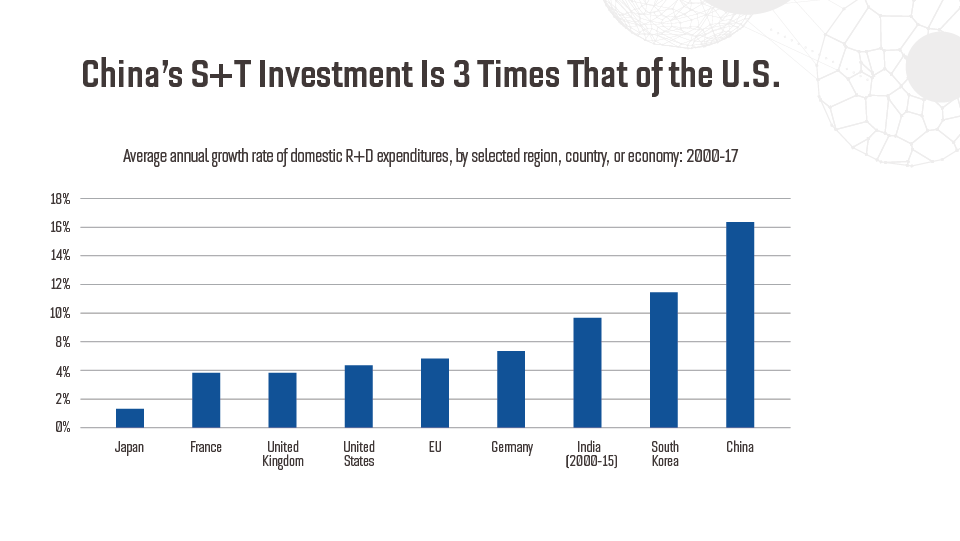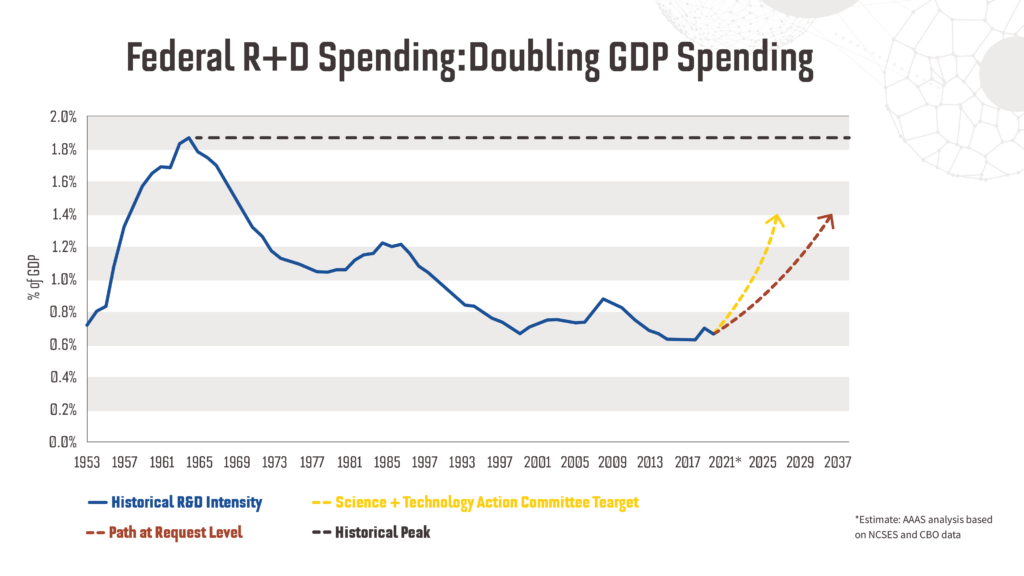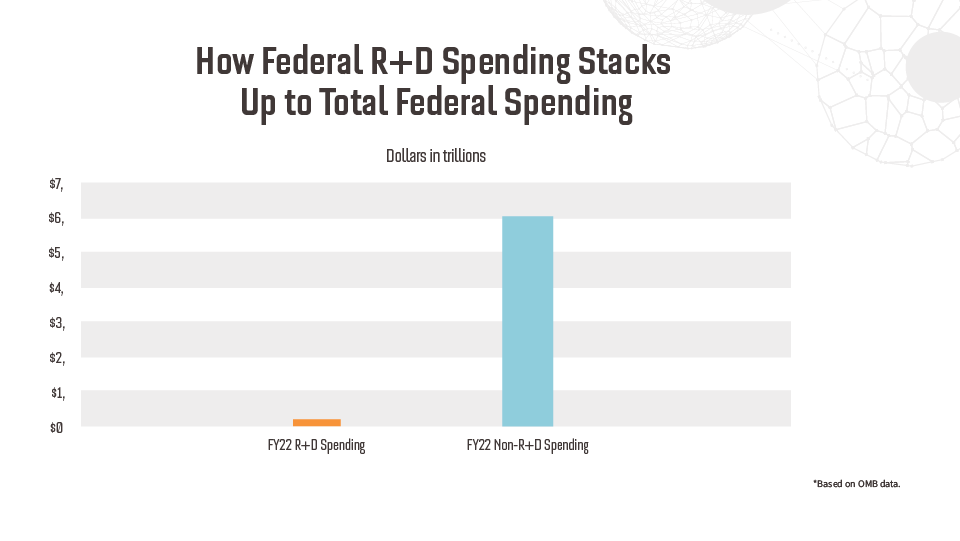Biden Administration’s Crucial Opportunity to Fuel American Competitiveness in Science and Technology
President Biden proposed a much-needed booster shot for American science and technology in his 2022 budget. But to fuel a true American restoration, we must wholeheartedly embrace science and technology research and development, coordination, and education. Additionally, the nation’s competitiveness with rising international science and tech powers requires a bold plan for sustained growth in investment over the long term. The Biden administration should set a target of at least doubling science and technology investment of GDP by 2026.
The Need to Invest in Ourselves to Drive Innovation for Our Nation and Our Planet
The U.S. – indeed, the global community – faces existential challenges that span public health, the environment, food and water, and energy. We can solve these crises, but only if we dramatically expand public investment in science and technology (S&T). For too long, we’ve taken our leadership in S&T for granted. Today, America invests just 0.7% of GDP in research and development (R&D) versus 1.9% in 1964. As a result, the U.S. has fallen to 14th globally in public investment in S&T as a percentage of GDP. At the same time, other nations are bolstering their capacity and talent to create and capture new markets. If we don’t raise our standing, the next great discoveries will happen elsewhere — and the U.S. will face missed economic growth and serious consequences that affect American’s health, security and livelihood.

As the U.S. underinvests in R&D, other nations, most notably China, are doubling their commitment to R&D.
Chinese researchers have outpaced ours in the number of scientific papers published each year, and China leads all other nations in number of patent grants. America still devotes more total dollars to research and development than any other nation, but experts predict we’ll lag behind China in total R&D spending by the end of this decade.
Biden Administration’s 2022 Budget Proposal for Science & Technology
Fortunately, the Biden administration recognizes the challenge, and its fiscal year (FY) 2022 budget proposal prioritizes scientific advancement through major investments in R&D and STEM education.
President Biden’s $1.52 trillion FY22 discretionary funding proposal includes significant increases in non-defense S&T spending, up 27% over 2021 budgets. It includes a $9 billion increase in the National Institutes of Health (NIH) budget, a $1.7 billion increase for the National Science Foundation (NSF), a 1.4 billion increase for the National Oceanic and Atmospheric Administration (NOAA), and a $2 billion increase for the Environmental Protection Agency (EPA), among other significant spending increases. These investments would boost S&T-related spending as a percentage of GDP, reversing a downward trend over the past five decades.
However, given the weight of the challenges we face and the strengthening of our global competition, what’s needed is not a short-term annual budget increase but a long-term plan for sustained federal investment in S&T. To get America back on track, the Science & Technology Action Committee (S-TAC) recommends at least doubling the investment of GDP in S&T.
2040 Is Too Late: The Science and Technology Funding Shortfall
How do we make American S&T investments globally competitive again? Analysis conducted by Matt Hourihan, director of the American Association for the Advancement of Science’s (AAAS) R&D Budget and Policy Program, puts S-TAC’s recommendation and the FY22 request together in a GDP context. The takeaway: the Biden administration’s request is significantly short of the S-TAC target of doubling the investment of GDP in S&T by 2026. Reaching this mark would require about 22% annual growth, while the Biden request recommends about 8.5% growth, or enough to get to 1.4% of GDP by around 2040.

To put current federal spending on S&T in perspective, the following bar chart with data provided by AAAS’ Matt Hourihan shows how federal R&D spending in Biden’s FY22 budget — amounting to $170 billion — compares to the total federal FY22 budget of $6 trillion. It’s tiny by comparison and we can and should spend more to develop the S&T solutions of the future.

A Long-term Science and Technology Solution
S-TAC sees two major opportunities to strengthen the proposal put forward by the Biden administration:
- Double federal R&D and STEM investments. Doubling federal expenditures for R&D and STEM education over a five-year period would dramatically expand the nation’s global competitiveness in research, technology and manufacturing. Further, it would help to build out critical physical infrastructure, like universal broadband access, and enable us to diversify our funding portfolio with some higher risk, higher reward research without robbing existing successful funding models. We could also address long-standing structural issues in S&T education and recruitment to ensure we are leveraging our greatest asset: our diverse human capital.
- Reinvigorate cross-agency science coordination. The independence of science and technology is an American strength, but coordination and collaboration between the more than 20 federal research agencies with scientific missions is more critical than ever in the face of national and global threats. Dedicated coordination and funding are needed to address large-scale, long-term challenges like public health and healthcare, environment and climate change, food and water security, and energy production, utilization and storage. We must empower the White House Office of Science and Technology Policy with the ability to strategically coordinate resources across government, industry and academia.
These steps will ensure our S&T endeavors have the long-term boost they need to keep America competitive and secure a better future for all.
Conclusion
President Biden’s proposed S&T investments would be a promising first step toward getting the U.S. back on track toward doubling investment in R&D, which is critical if we are to meet today’s challenges. But even greater funding levels are needed to make a meaningful and necessary impact on the U.S.’s ability to out-innovate our global competitors, like China. We can’t wait. Additional funding and greater strategic federal coordination of the government’s S&T enterprise is needed now.
It’s crucial to the nation’s future that our political leaders set us on a steady and sustainable long-term path by prioritizing funding and the strategic coordination of our federal S&T mission.
About the Science and Technology Action Committee
The Science and Technology Action Committee is a group of 22 non-profit, academic, foundation, and corporate leaders working to dramatically strengthen U.S. science and technology. The committee is co-chaired by Keith Yamamoto, vice chancellor for science policy and strategy at University of California San Francisco; Sudip Parikh, CEO, the American Association for the Advancement of Science; and Mary Woolley, president and CEO, Research!America.
About the Science and Technology Action Plan
The action plan provides a roadmap for the U.S. to reprioritize S&T research, development and education. Close to 80 organizations — including Google, Johns Hopkins University, the American Psychological Association, the American Heart Association, ScienceCounts, IBM and Indiana University — have endorsed the action plan.
